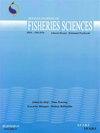波斯鲟种群遗传结构分析:对照区测序和线粒体DNA PCR-RFLP分析的比较
IF 0.6
4区 农林科学
Q3 FISHERIES
引用次数: 3
摘要
采用线粒体DNA (mtDNA)核苷酸脱氢酶亚基5 (ND5)的聚合酶链反应(PCR)限制性片段长度多态性(RFLP)分析方法,对波斯鲟acpenser persicus (Borodin, 1897)的遗传变异和种群结构进行了研究。我们将这些数据与之前基于mtDNA控制区序列的研究结果进行了比较。在南部的23个采样点和土库曼斯坦、阿塞拜疆、俄罗斯联邦和哈萨克斯坦的4个采样点共收集到225只个体,覆盖里海南部、中部和北部三个主要地理区域。PCR产物用25种限制性内切酶进行酶切,发现5种酶(Rsa І、Hinf І、HaeIII、Mbo І和Cfr13І)具有多态性。共发现32个复合单倍型,每个群体样本的单倍型数量在6 ~ 13个之间。聚类和分子方差模型(AMOVA)分析明确了两个区域(塞菲鲁德河和俄罗斯)群体。这些群体中的每一个都显示出优势单倍型,而这些单倍型在其他地理区域的人群中很少。平均单倍型多样性(h)和核苷酸多样性(π)分别为0.7610±0.046和0.008332±0.00421。基于异质性检验和蒙特卡罗1000次重复,波斯鲟种群的单倍型频率差异显著(p <0.0001)。所得结果和基于kimura- 2参数法的FST均显示单倍型在不同地点的分布具有显著性(p <0.0001)。这项研究的结果确定了波斯鲟的独立种群,并将对鲟鱼的保护遗传学具有显著的意义。本文章由计算机程序翻译,如有差异,请以英文原文为准。
Analysis of the genetic structure of the Persian sturgeon (Acipenser persicus) populations: Comparison of control region sequencing and PCR-RFLP analysis of mitochondrial DNA
The genetic variation and population structure of the Persian sturgeon, Acipenser persicus (Borodin, 1897) was investigated by means of polymerase chain reaction (PCR) restriction fragment length polymorphism (RFLP) analysis of the nucleotide dehydrogenase subunit 5 (ND5) of mitochondrial DNA (mtDNA). We compared these data with our previous study based on mtDNA control region sequences. A total of 225 individuals were collected from 23 sample sites in the south and 4 locations in Turkmenistan, Azerbaijan, Russian Federation and Kazakhstan covering the three main geographic regions including south, middle and north part of the Caspian Sea. The PCR products were digested with 25 restriction enzymes and five enzymes revealed polymorphism patterns (Rsa І, Hinf І, HaeIII, Mbo І and Cfr13І). Thirty two composite haplotypes were revealed with the number of haplotypes in each population sample ranging from 6 to 13. Two regional (Sefidroud River and Russia) groups were clearly identified by cluster and molecular variance model (AMOVA) analyses. Each of these groups showed dominant haplotypes that were little in populations from the other geographic areas. The mean haplotype diversity (h) and nucleotide diversity (π) were 0.7610±0.046 and 0.008332±0.00421, respectively. Based on heterogeneity test and Monte-Carlo with 1000 replicates, significant differences were showed for haplotype frequencies of the Persian sturgeon populations (p <0.0001). The obtained results and also FST based on kimura- 2 parameters method showed that haplotype distribution in different location were significant (p <0.0001). Results of this study determined independent populations of Persian sturgeon and will have noticeable implications for sturgeon conservation genetics in general.
求助全文
通过发布文献求助,成功后即可免费获取论文全文。
去求助
来源期刊

Iranian Journal of Fisheries Sciences
FISHERIES-
CiteScore
2.30
自引率
11.10%
发文量
0
审稿时长
3 months
期刊介绍:
1- Living various species (contains animals and vegetal species) in various aquatic ecosystems.
2- Health and diseases of aquatic species.
3- Determining the stocks and specific time and location for catching and reliable exploitation for sustainable development.
4- Methods of propagation and culture of high value aquatic resources.
5- Aquatic stock assessment and the methods of restocking the high value species and suggestion for rate, areas and the time for releasing fish and other aquatic organisms fries.
6- Pollutant agents and their effects to the environments of aquatic species.
7- Feed and feeding in aquatic organisms.
8- Fish processing and producing new products.
9- The economic and social aspects of fisheries.
 求助内容:
求助内容: 应助结果提醒方式:
应助结果提醒方式:


